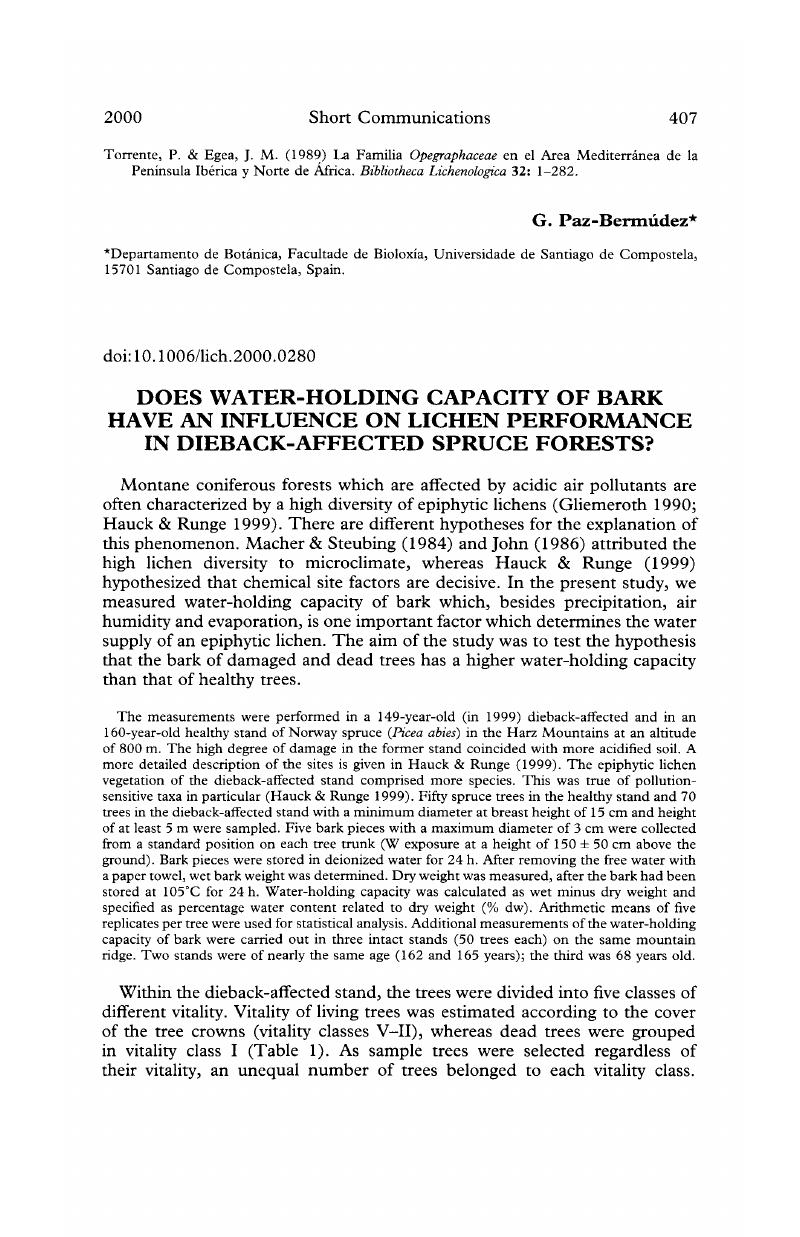Crossref Citations
This article has been cited by the following publications. This list is generated based on data provided by Crossref.
Esslinger, Theodore L.
2000.
Recent Literature on Lichens—179*.
The Bryologist,
Vol. 103,
Issue. 4,
p.
816.
Hauck, Markus
and
Runge, Michael
2002.
Stemflow chemistry and epiphytic lichen diversity in dieback-affected spruce forest of the Harz Mountains, Germany.
Flora - Morphology, Distribution, Functional Ecology of Plants,
Vol. 197,
Issue. 4,
p.
250.
Hauck, Markus
Hesse, Volker
and
Runge, Michael
2002.
Correlations between the Mn/Ca ratio in stemflow and epiphytic lichen abundance in a dieback-affected spruce forest of the Harz Mountains, Germany.
Flora - Morphology, Distribution, Functional Ecology of Plants,
Vol. 197,
Issue. 5,
p.
361.
Hauck, Markus
2003.
Epiphytic Lichen Diversity and Forest Dieback: The Role of Chemical Site Factors*.
The Bryologist,
Vol. 106,
Issue. 2,
p.
257.
Loppi, Stefano
and
Frati, Luisa
2004.
Influence of Tree Substrate on the Diversity of Epiphytic Lichens: Comparison Between Tilia platyphyllos and Quercus ilex (Central Italy).
The Bryologist,
Vol. 107,
Issue. 3,
p.
340.
Hauck, Markus
2005.
Epiphytic lichen diversity on dead and dying conifers under different levels of atmospheric pollution.
Environmental Pollution,
Vol. 135,
Issue. 1,
p.
111.
Benner, Jon W.
and
Vitousek, Peter M.
2007.
Development of a diverse epiphyte community in response to phosphorus fertilization.
Ecology Letters,
Vol. 10,
Issue. 7,
p.
628.
Fritz, Örjan
Brunet, Jörg
and
Caldiz, Mayra
2009.
Interacting effects of tree characteristics on the occurrence of rare epiphytes in a Swedish beech forest area.
The Bryologist,
Vol. 112,
Issue. 3,
p.
488.
Hauck, Markus
2011.
Site factors controlling epiphytic lichen abundance in northern coniferous forests.
Flora - Morphology, Distribution, Functional Ecology of Plants,
Vol. 206,
Issue. 2,
p.
81.
Marmor, L.
Tõrra, T.
Saag, L.
and
Randlane, T.
2011.
Effects of forest continuity and tree age on epiphytic lichen biota in coniferous forests in Estonia.
Ecological Indicators,
Vol. 11,
Issue. 5,
p.
1270.
Leuschner, Christoph
and
Ellenberg, Heinz
2017.
Ecology of Central European Forests.
p.
729.
McDonald, L.
Van Woudenberg, M.
Dorin, B.
Adcock, A.M.
McMullin, R.T.
and
Cottenie, K.
2017.
The effects of bark quality on corticolous lichen community composition in urban parks of southern Ontario.
Botany,
Vol. 95,
Issue. 12,
p.
1141.
Endres Júnior, Delio
Sasamori, Márcio Hisayuki
Petry, Camila Tamires
Santos, Miguel da Silva
and
Droste, Annette
2019.
Host tree bark traits and development of reintroduced Cattleya intermedia (Orchidaceae) plants in Southern Brazil.
Rodriguésia,
Vol. 70,
Issue. ,
Llewellyn, Theo
Gaya, Ester
and
Murrell, David J.
2020.
Are Urban Communities in Successional Stasis? A Case Study on Epiphytic Lichen Communities.
Diversity,
Vol. 12,
Issue. 9,
p.
330.
Ansaldo, Diego
Vergara, Pablo M.
Carvajal, Mario A.
Alaniz, Alberto J.
Fierro, Andrés
ReinaldoVargas-Castillo
Quiroz, Madelaine
Moreira-Arce, Darío
and
Pizarro, Jaime
2021.
Tree decay modulates the functional response of lichen communities in Patagonian temperate forests.
Science of The Total Environment,
Vol. 771,
Issue. ,
p.
145360.
Rinas, Christina L.
McMullin, R. Troy
Rousseu, François
and
Vellend, Mark
2023.
Diversity and assembly of lichens and bryophytes on tree trunks along a temperate to boreal elevation gradient.
Oecologia,
Vol. 202,
Issue. 1,
p.
55.



